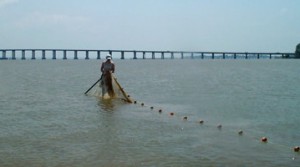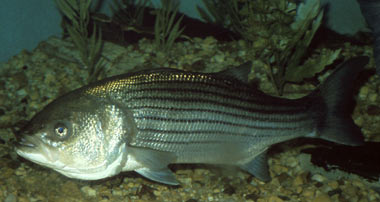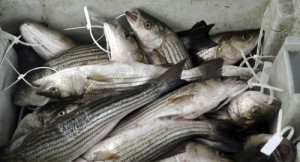Decline blamed on weather; no catch restrictions planned
By Timothy B. Wheeler, The Baltimore Sun
[dropcap]T[/dropcap]he number of young striped bass in the Chesapeake Bay fell to a record low this year, a drastic decline from a near-record high the year before, state officials reported Tuesday.
State biologists checking Maryland’s part of the bay found the fewest newly spawned striped bass that they’ve tallied in any year since annual surveys for the fish began 59 years ago, the Department of Natural Resources reported.
Maryland’s state fish, also known as rockfish, is closely monitored because it supports a multimillion-dollar recreational and commercial fishing industry that employs thousands. The species is widely regarded as one of the bright spots in the 30-year effort to restore the Chesapeake Bay; its population rebounded from near-collapse in the 1980s after a five-year fishing moratorium.
Though state officials said the decline probably was the result of unfavorable weather during spawning season, some recreational fishing advocates urged vigilance.
“We expected the numbers to be low, but by no means did we expect them to be this low,” said Tony Friedrich, executive director of the Coastal Conservation Association of Maryland. “It does concern us.”
The upper bay is the spawning ground and nursery for three-fourths of the striped bass that migrate along the East Coast.
In the Maryland survey, the number of little striped bass counted in each haul during a three-month sampling of traditional spawning areas was more than 90 percent below the long-term average.
Virginia scientists reported similarly poor reproduction in their survey of the southern portion of the bay.
DNR officials said there appeared to be plenty of adult striped bass returning to the bay’s rivers to spawn this year, but that unusually warm, dry weather last winter and spring spelled doom for their offspring.
Eric Durell, leader of the department’s striped bass survey, said newly hatched larvae are particularly sensitive to environmental conditions such as the flow, clarity and temperature of the water. In past years when ample rain fell around spawning season, the number of juvenile fish found was higher, he noted, but this year saw near-record low flows in bay tributaries.
“We think that this year we just did not have the flow necessary for larval survival,” Durell said.
Similar fish such as white perch, river herring and yellow perch also had poor reproduction this year, bolstering scientists’ belief that weather was to blame for the striped bass decline. Like striped bass, those species return to spawn in rivers after spending much of their lives in the Atlantic Ocean.
State officials said reproduction varies from year to year, so even this extremely poor showing was no cause to clamp down on fishing.
“One year of reproductive failure isn’t itself a disaster for a species like this,” said Durell. “We’re not overfished; we’re not overfishing.”
He said that the number and age range of adult fish remains good but noted that scientists are in the midst of taking a new look at the health of the striped bass population, which should be finished next year.

The striped bass (Morone saxatilis) is one of the most sought-after commercial and recreational finfish in Chesapeake Bay. A juvenile striped bass seine survey (Virginia) monitors the abundance of this important resource.
Last year’s survey found the fourth-highest number of juvenile striped bass ever, easing anxiety about the species’ sustainability. Spawning survival had been sub-par in four of the previous five years, and many adult fish in the bay have been suffering from mycobacteriosis, a disease that some have linked to a shortage of food for striped bass, particularly menhaden.
Until the 2011 uptick, the Atlantic States Marine Fisheries Commission, which regulates fishing in coastal waters, was considering a proposal to reduce the striped bass harvest by 40 percent.
Lynn Fegley, assistant state fisheries director, said the commission’s striped bass management plan does not require harvest reductions unless there are three years of poor reproduction in a row.
Commission members have talked about increasing conservation efforts for striped bass, Fegley acknowledged, but she said the current plan has been successful at sustaining the fish population despite reproduction ups and downs.
William Goldsborough, senior fisheries scientist with the Chesapeake Bay Foundation and a member of the Atlantic States commission, said the drop is “certainly something to keep an eye on – but I’m not terribly concerned.”
Independent fisheries experts said the poor reproduction this year was not cause for panic, because striped bass can spawn repeatedly over their lifespan and good years can balance out the bad.
“This is a fish that has many times at bat,” said David Secor, a fisheries ecologist with the University of Maryland Center for Environmental Sciences. “It can wait out a year or two or three, maybe more.”
But “if we have more of these years,” Secor added, “it means we could have diminished fisheries.”
[information]
Baltimore Sun online
[/information]








